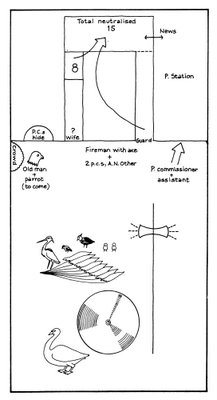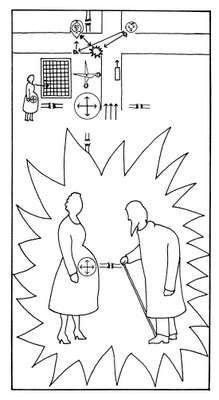I'm interested in the heterogeneity of these drawings. The top tends to be closer to a "pure" diagram. Moving down the page, we find representational images. Often (and we've seen this clearly in the first two diagrams) the same elements are reworked in different forms: a seemingly abstract tracing of movements through space becomes first an airman, then a vaccinated dog; here, a bird's head as icon for a parrot is echoed below by fully-fledged line drawings of a stork, a goose.
Other elements hover between what Peirce would call the iconic and the symbolic. The line at the bottom right here, for instance, both continues the line of the diagrammed fire station wall above, and becomes part of a skeletal representation of a fire alarm, dotted lines symbolizing the klaxon's sounds blaring to both sides, picking up the arrow above that indicates news permeating outside and inside.

The diagrams encompass both the known and the unknown, the definite and the probable--better, the virtual and the actual. Near a semicircle containing the denotation "P.C.s hide," presented as a record of the raid, is the word "wife" with a question mark hovering above. Is a wife located there, perhaps separated out from the crowd on the left-hand side? Is it a woman, who may or may not be somebody's wife? Or is there nobody at all? Or not yet, for the diagram notes future as well as past: just below the line that divides upper from lower, (floor) plan from artistic (execution), is the bird symbol and the observation "Old man + parrot (to come)." When are this pair to come? How will they enter into the action?
The diagram is the record of the plan, the virtual marshalling of guerilla forces, but also the record of its actualization, and the way in which actualization entails the elimination of incompossible worlds: the virtual is a garden of forking paths that can enfold divergent outcomes, in one of which, say, all adversaries are neutralized, in another of which mistakes occur and a back-up plan has to be sought; as the plan is actualized, at all these points of divergence only one outcome can ensue, either neutralization or back-up.
The next diagram in the series depicts (or draws from) a raid on a telephone exchange. Again, the visual plane is split between a more fully diagrammatic top third, and a more representational lower two thirds. Again, however, there are echoes and resonances between the two sections. A pregnant woman appears first as symbol, then as icon: first, that is, as a conventional sign, like the images representing gender on bathroom doors; second, as a sign that seems to garner its meaning more through resemblance, as though it indicated a specific woman, rather than woman in general.

The cut cables are also duplicated at top and at bottom, but again with rather different connotations: first to locate the site of sabotage; second to indicate a more fundamental communicational impasse between the woman and the bearded man with a cane. But perhaps the image now also suggests a cut umbilical cord? It's a cut that's at the centre of the generalized flashpoint that envelops the larger part of the diagram, echoing the flash at the top at a street corner subject to a complex network of spectatorship and surveillance.
In the accompanying poem, "Central," Oliver entwines the story of the Tupamaro raid with a dialogue with his dead child, Tom: a strained, broken, and finally impossible communication.
[. . .] I saw the airman signal and I got it. I heard Tom's voice as from a distant receiver and I got it. Seven guerrillas tying up the telephone exchange expertly. then Tom's voice said, "Hallo Central,"
from the booth of death.
[. . .]
Tom, go ahead.
and I'd like to have friends on these streets, friends
who'd look for me in creations of total emergency
in or out of dreams . . . Cut . . . A guerrilla command tone:
"Place the pregnant
woman into the temporary prison with the 40
communication functionaries and consumers. Get on with this.
Cut other connections yourself but obey
the voices that come from long distance, obey sound and feeling."
Tom, go ahead.
But my Tom's in a frightener cell
of the night of youth
where old and young eyes shine and are grey
and the ears fold in
to the internal sounds.
No comments:
Post a Comment